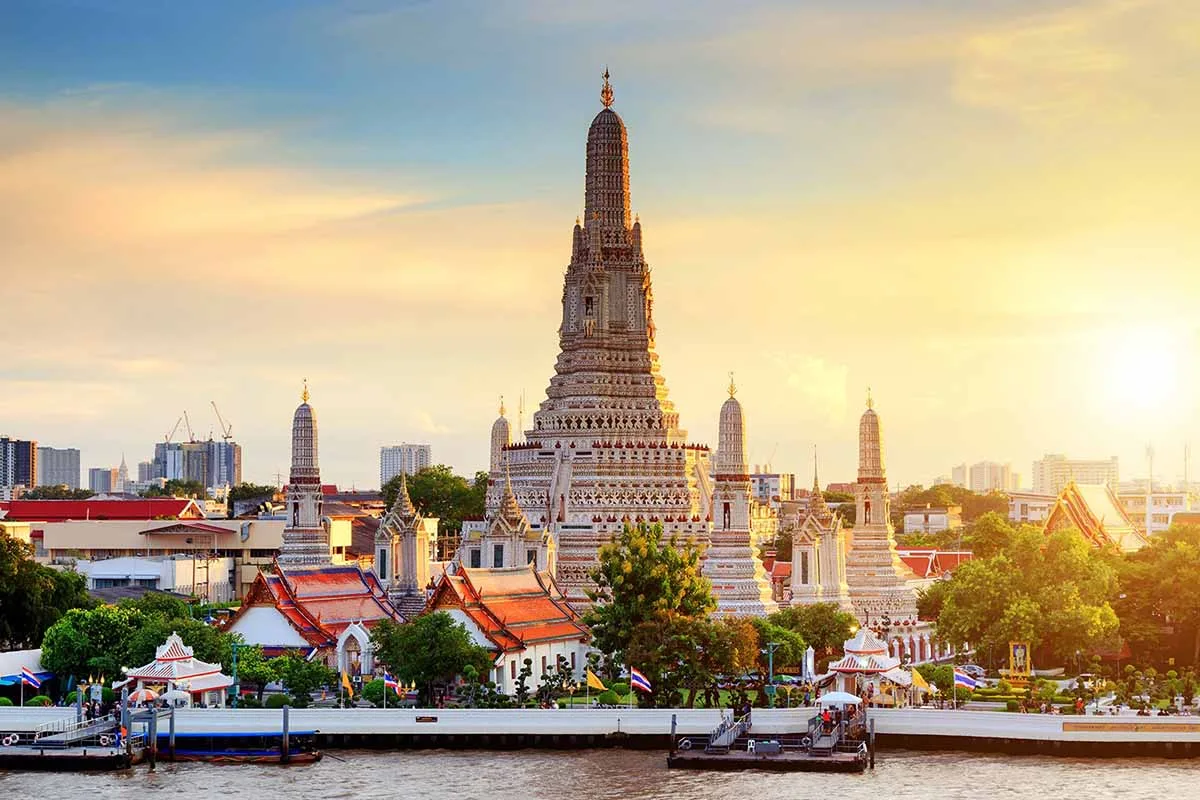What is Wat Arun?
Wat Arun, also known as the Temple of Dawn, is one of Bangkok’s most famous landmarks. Located on the west bank of the Chao Phraya River, this stunning temple is known for its towering spires, intricate decorations, and breathtaking sunset views. Whether you’re a history buff, architecture enthusiast, or just someone looking for the perfect Instagram shot, Wat Arun is a must-see attraction in Thailand’s capital.
A Temple That Catches the First Light
Despite being called the Temple of Dawn, Wat Arun looks its best at sunset, glowing beautifully with golden light. It’s like Bangkok’s way of saying, “Yes, I know my name, but I do what I want.” The temple is dedicated to Aruna, the Hindu god of the rising sun, and has been standing tall since the Ayutthaya period, undergoing several renovations over the centuries.
Architectural Marvel: Where Porcelain Meets Grandeur
Unlike other temples in Thailand that are covered in gold, Wat Arun takes a different approach – it’s decorated with colorful porcelain and seashells. Some say the Chinese porcelain pieces used to decorate the temple came from broken plates and teacups transported on trading ships. Who knew recycling could look this majestic?
The temple’s central prang (Khmer-style tower) stands at around 70 meters (230 feet) high, making it one of the tallest religious structures in Bangkok. Climbing to the top rewards visitors with stunning panoramic views of the Chao Phraya River and the city skyline—though your legs might not thank you for the steep ascent.
A Temple With a Storied Past
Wat Arun’s history dates back to the 17th century, but it gained its current name and significance when King Taksin made it part of his royal temple after liberating Siam from Burmese control. For a brief moment, Wat Arun even housed the Emerald Buddha before it was moved to Wat Phra Kaew.
How to Visit Wat Arun Like a Pro
- Opening Hours: 8:00 AM – 6:00 PM daily
- Entrance Fee: 100 THB (~$3)
- Dress Code: Cover shoulders and knees (or rent a sarong at the entrance if you forget)
- Best Time to Visit: Early morning for fewer crowds, or late afternoon for the best photos
- Getting There: Take a boat across the river from Tha Tien Pier, because arriving at a temple by boat just feels cooler.
Fun Facts You Probably Didn’t Know
- Wat Arun’s spires are built using bricks and mortar, then covered in beautiful porcelain pieces. It’s basically the most elegant mosaic puzzle ever made.
- The temple appears on the 10 Baht coin. Yes, that change in your pocket might just have a piece of Wat Arun with you.
- Despite being a Buddhist temple, its design has strong Hindu influences, making it a fascinating blend of cultures.
FAQs About Wat Arun
Why is Wat Arun called the Temple of Dawn?
It’s named after Aruna, the Hindu god of dawn, and was meant to catch the first light of the day. Ironically, it looks most stunning at sunset.
Is Wat Arun worth visiting?
Absolutely! Whether you love history, photography, or just want to see Bangkok from above, Wat Arun offers an unforgettable experience.
How long does it take to explore Wat Arun?
A visit typically takes 1-2 hours, depending on how many photos you take (and trust us, you’ll take a lot!).
Can I climb to the top of Wat Arun?
Yes! There’s a steep staircase leading to the central prang, where you’ll get breathtaking views of Bangkok.
What should I wear to Wat Arun?
Modest clothing is required—shoulders and knees should be covered. If you forget, you can rent cover-ups at the entrance.
Wat Arun is more than just a temple; it’s a symbol of Bangkok’s rich heritage and artistic beauty. Whether you’re soaking in the sunrise, climbing the steep steps, or just admiring the sparkling porcelain tiles, this temple is sure to leave a lasting impression. So, pack your camera, wear comfortable shoes, and get ready for an unforgettable adventure at the Temple of Dawn!
